
Gojong, personal name Yi Myeongbok, later Yi Hui, also known as the Gwangmu Emperor, was the penultimate Korean monarch. He ruled Korea for 43 years, from 1864 to 1907, first as the last king of Joseon, and then as the first emperor of the Korean Empire from 1897 until his forced abdication in 1907. His wife, Queen Min, played an active role in politics until her assassination carried out by the Japanese.

Sunjong, personal name Yi Cheok, also known as the Yunghui Emperor, was the last Korean monarch. He ruled from 1907 to 1910 as the second and last emperor of the Korean Empire. Sunjong was elevated to the throne after his predecessor and father, Gojong, was forced to abdicate by the Empire of Japan. Hence, Sunjong has been characterized by historians as being a powerless puppet ruler of the Japanese, reigning for just three years before Korea was officially annexed in 1910.
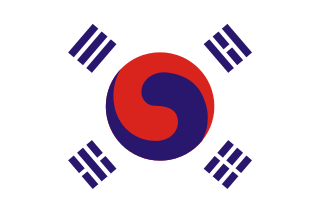
The Korean Empire, officially the Empire of Korea or Imperial Korea, was a Korean monarchical state proclaimed in October 1897 by King Gojong of the Joseon dynasty. The empire lasted until Japan's annexation of Korea in August 1910.

Taejo, personal name Yi Sŏng-gye, later Yi Tan, was the founder and first monarch of the Joseon dynasty of Korea. After overthrowing the Goryeo dynasty, he ascended to the throne in 1392 and abdicated six years later during a strife between his sons. He was honored as Emperor Go following the establishment of the Korean Empire.
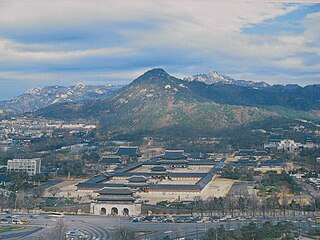
Gyeongbokgung, also known as Gyeongbok Palace or Gyeongbokgung Palace, was the main royal palace of the Joseon dynasty. Built in 1395, it is located in northern Seoul, South Korea. The largest of the Five Grand Palaces built by the Joseon dynasty, Gyeongbokgung served as the home of the royal/imperial family and the seat of government.
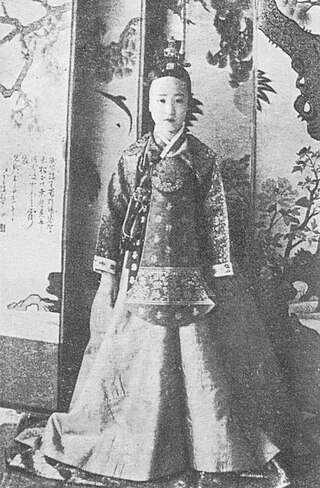
Princess Deokhye of Korea was the last princess of the Korean royal family.

Taejo, personal name Wang Kŏn, also known as Taejo Wang Kŏn, was the founder of the Goryeo Dynasty of Korea. He ruled from 918 to 943, achieving unification of the Later Three Kingdoms in 936.

Heungseon Daewongun was the title of Yi Ha-eung, the regent of Joseon during the minority of Emperor Gojong in the 1860s. Until his death, he was a key political figure of late Joseon Korea. He was also called the Daewongun, Guktaegong, or later Internal King Heonui, and also known to contemporary western diplomats as Prince Gung.

The House of Yi, also called the Yi dynasty, was the royal family of the Joseon dynasty and later the imperial family of the Korean Empire, descended from the Joseon founder Yi Seong-gye. All of his descendants are members of the Jeonju Yi clan.

The Japan–Korea Treaty of 1905, also known as the Eulsa Treaty, Eulsa Unwilling Treaty or Japan–Korea Protectorate Treaty, was made between the Japanese Empire and the Korean Empire in 1905. Negotiations were concluded on November 17, 1905. The treaty deprived Korea of its diplomatic sovereignty and made Korea a protectorate of Imperial Japan. It resulted from Imperial Japan's victory in the Russo-Japanese War in 1905.
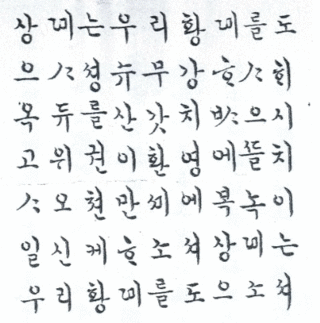
The "Patriotic Hymn of the Great Korean Empire" was the national anthem of the Korean Empire during the 1900s. It was the first and only national anthem of a unified Korean state to date.
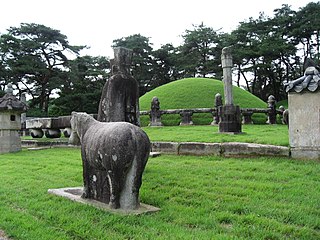
The Tombs of the Joseon dynasty refers to the 40 tombs of members of the House of Yi, which ruled Korea between 1392–1910. These tombs are scattered over 18 locations across the Korean Peninsula. They were built to honor and respect the ancestors and their achievements and assert their royal authority. The tombs have been registered as an UNESCO World Heritage Site since 2009. Two other Joseon tombs, located in Kaesong, North Korea, were proposed but not submitted.
The Joseon dynasty ruled Korea from 1392 to 1897.
Imperial titles were used in various historical Korean states before the 14th century and at the turn of the 20th century: Early Korean states used "great king", "greatest king", and "holy king"; later Korean states used "emperor". Korean monarchs who used imperial titles had political and religious authority over a realm or domain. The Chinese concept of tianxia, pronounced "cheonha" in Korean, was variously adopted and adapted to Korean views of the world from period to period.
Emperor at home, king abroad was a system of conducting relations between states within the Chinese cultural sphere. Rulers of lesser regimes would adopt the title of emperor and/or other imperial titles domestically, and adopt the title of king when dealing with the dominant Chinese regime. Instead of using the styles Imperial Majesty and Majesty (陛下), rulers of lesser realms were styled as Highness (殿下). This system was applicable to Japan, Korea and Vietnam, as well as less powerful Chinese states, among others.
Consort Jeong may refer to:
The following is a family tree of Korean monarchs.











